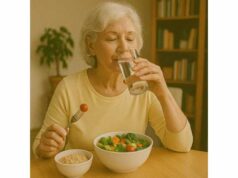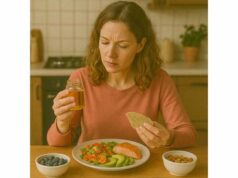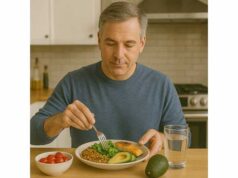
High blood pressure becomes more common with age, but it is not inevitable. Food affects pressure through multiple levers—how much fluid you retain, how responsive your blood vessels stay, and whether your kidneys excrete or hold sodium. With the right pattern, many people see measurable improvements within weeks and maintain those gains over months. This guide translates the best evidence into everyday choices: smarter sodium and potassium balance, a practical DASH-style plate, nitrate-rich vegetables, label-reading skills, and home monitoring that validates progress. If you want a broader foundation for building a long-lived diet, review the core principles of healthy patterns and proteins in nutrition for longevity, then apply the targeted strategies here to move your blood pressure in the right direction.
Table of Contents
- How Diet Affects Blood Pressure and Arterial Health
- Sodium and Potassium Balance: Practical Food Swaps
- DASH Essentials: Fruits, Vegetables, and Low Fat Dairy
- Nitrate Rich Greens and Beets: What to Expect
- Alcohol, Caffeine, and Meal Timing Considerations
- Reading Labels for Hidden Sodium
- Home Monitoring and When to Escalate Care
How Diet Affects Blood Pressure and Arterial Health
Blood pressure reflects the force of blood against artery walls. It rises when arteries stiffen, when the kidneys retain more sodium and water, or when stress hormones keep vessels constricted. Diet shapes each pathway. Sodium pulls water into the bloodstream; potassium encourages sodium excretion and relaxes vessel walls; calcium and magnesium support vascular tone; and polyphenols and dietary nitrates improve endothelial function—the signaling system that helps arteries dilate on demand.
Two patterns push pressure upward. The first is sodium excess, common in restaurant meals, breads and wraps, cured meats, soups, and sauces. Many people unknowingly exceed 3,000–3,500 mg of sodium daily. The second is low potassium intake, typical when fruits, vegetables, legumes, and dairy are scarce. The sodium-to-potassium ratio matters more than either number alone; you want sodium down and potassium adequate, unless you have a medical reason to limit potassium.
Weight and insulin resistance also influence pressure. Visceral fat and frequent high-glycemic meals raise sympathetic activity and increase renal sodium reabsorption. Trimming refined carbohydrates and added sugars can lower blood pressure even without major weight loss. A plate built on intact grains, legumes, vegetables, and low-fat dairy typically reduces systolic pressure within weeks, with larger drops in people who start higher.
Fat quality plays a supporting role. Replacing saturated fat (butter, fatty cuts of meat, coconut oil) with unsaturated fat (olive oil, nuts, seeds, fish) can improve endothelial function and reduce low-grade inflammation, helping arteries stay compliant. Omega-3–rich fish adds a triglyceride benefit and may modestly improve central (aortic) pressure when it displaces ultra-processed foods.
Finally, dietary nitrates from leafy greens and beets convert to nitric oxide, a natural vasodilator. Combined with controlled sodium and adequate potassium, these choices create a food-first plan that targets several mechanisms at once.
Key takeaways for action
- Lower sodium and maintain adequate potassium; the ratio matters.
- Center meals on vegetables, fruits, legumes, intact grains, and low-fat dairy; use olive oil as the default fat.
- Include nitrate-rich greens or beets several times weekly.
- Expect early wins in 2–6 weeks; keep going for 8–12 weeks to see the full effect.
Sodium and Potassium Balance: Practical Food Swaps
Think in terms of ratios. Most adults benefit from less sodium and more potassium from foods, unless restricted by kidney disease, certain medications, or clinician guidance. You do not need perfect tracking; repeated swaps shift the balance day after day.
Where sodium hides
- Breads and wraps: Two slices of sandwich bread can add 250–350 mg sodium before fillings.
- Processed proteins: Deli meats, sausages, smoked fish, and marinated poultry often contribute 400–900 mg per serving.
- Canned soups and broths: 600–900 mg per cup is common; “reduced sodium” can still be high.
- Sauces and condiments: Soy sauce, jarred pasta sauces, salad dressings, and pickles can push a meal over 1,000 mg quickly.
- Restaurant meals: Many entrées contain 1,200–2,000 mg, not counting sides.
Potassium: the quiet lever
- Potassium supports vasodilation and sodium excretion. Rich sources include beans and lentils, potatoes (with skins), leafy greens, squash, tomatoes, bananas, citrus, yogurt, and milk. When these replace salted, processed items, your sodium-to-potassium ratio improves—even if calories stay similar.
Simple swaps that add up
- Sandwich: replace deli ham with mashed white beans, sliced tomato, arugula, and olive oil on low-sodium whole-grain bread.
- Soup: use no-salt-added tomatoes and broth; add unsalted chickpeas and finish with lemon and herbs.
- Starch: bake a potato and top with plain yogurt, chives, and olive oil instead of salted butter or cheese sauce.
- Salad: make a quick vinaigrette (olive oil, vinegar, mustard) in place of bottled dressing.
- Breakfast: trade salted cereal and toast for steel-cut oats cooked in milk, topped with berries and walnuts.
Targets and practical benchmarks
- Many adults can reach <2,300 mg sodium/day with modest changes; your clinician may recommend a lower target based on risk and tolerance.
- Most benefit from ~3,000–3,500 mg potassium/day from food unless restricted; spread intake across meals to avoid stomach upset.
Travel and eating out
- Scan menus for roasted fish or chicken; request sauces on the side and skip brined or blackened items.
- Choose steamed rice, baked potatoes, or unsalted beans over fries.
- Pack a “hotel kit”: low-sodium instant oats, unsalted nuts, and no-salt-added tuna or beans.
For a deeper dive into daily tactics that balance these minerals without fuss, see our practical guide to sodium and potassium strategies.
DASH Essentials: Fruits, Vegetables, and Low Fat Dairy
The Dietary Approaches to Stop Hypertension (DASH) pattern remains one of the most reliable foundations for older adults. It is a feeding pattern, not a short-term diet. Its core: high produce volume, regular low-fat dairy, ample legumes and whole grains, lean proteins, and limited saturated fat, sweets, and sodium. This mix delivers potassium, calcium, magnesium, fiber, and polyphenols that support vascular tone and endothelial function, lowering blood pressure even without weight loss.
What a DASH-aligned day looks like
- Vegetables and fruits: target 8–10 half-cup servings daily. Include at least one leafy green and one berry or citrus serving for potassium and polyphenols. Use frozen and canned (no-salt-added) to reduce cost and waste.
- Low-fat dairy: 2–3 daily servings (milk or yogurt) supply potassium, calcium, and peptides that aid vasodilation. Choose plain versions and flavor at home.
- Whole grains: oats, barley, quinoa, brown rice, whole-wheat pasta. Oats and barley add β-glucan fiber that also helps with cholesterol management.
- Protein: beans and lentils most days; fish or poultry several times weekly; tofu or tempeh for variety; nuts and seeds in modest daily portions.
- Fats: olive oil as the default; minimize butter and coconut oils.
Expected changes and timelines
- Many adults see systolic reductions of ~5–11 mmHg and diastolic reductions of ~2–6 mmHg within 2–4 weeks. Effects are larger if you start with higher readings and if you combine DASH with sodium reduction.
- Keep your pattern steady for 8–12 weeks before judging the full effect, especially if medications are being adjusted.
Implementation shortcuts
- Build a rotation of two breakfasts, two lunches, and four dinners. Repeat them with simple variations rather than chasing novelty.
- Use “anchors”: a bean-and-vegetable soup, yogurt-and-fruit bowls, and big salads with olive oil. These hit key nutrients with minimal planning.
- Keep a produce pipeline by pairing hardy items (carrots, cabbage, frozen greens) with tender ones (spinach, berries) so you always have options.
Common stumbling blocks and solutions
- Hidden sodium: neutralize with homemade dressings, unsalted beans, and simple roasted proteins.
- Low appetite or dental issues: rely on blended soups, yogurt parfaits, overnight oats, and soft fruit cups.
- Budget: frozen vegetables, dry beans, and bulk whole grains keep costs predictable.
For a simple plate-building framework that fits DASH and makes weekly planning easier, review our practical approach to heart-healthy plates.
Nitrate Rich Greens and Beets: What to Expect
Leafy greens (arugula, spinach, romaine), celery, fennel, and beets are rich in inorganic nitrate. Oral bacteria convert nitrate to nitrite, then to nitric oxide (NO), which relaxes vascular smooth muscle and improves endothelial function. In practical terms, this means more responsive arteries and small but meaningful pressure reductions layered on top of a DASH-style base.
What the numbers look like
- Trials using beetroot juice commonly report systolic reductions of ~3–5 mmHg over weeks, with variable diastolic effects. While modest, this effect becomes clinically relevant when combined with sodium reduction, adequate potassium, and weight management.
- Consistency matters: including nitrate-rich foods most days yields better results than occasional use.
How to use this lever safely
- Food-first: build a daily salad on nitrate-rich greens; add roasted or pickled beets several times weekly.
- Juice options: if you choose beetroot juice, look for products that standardize nitrate content and consider ~70–250 mL/day. Check for added sugars and sodium; quality varies widely.
- Mouthwash caution: antiseptic mouthwashes can blunt nitrate-to-nitrite conversion by reducing beneficial oral bacteria. Use only when medically needed.
- Kidney stone context: rotate greens (e.g., romaine, arugula) if you have a history of calcium oxalate stones; follow your clinician’s guidance.
Everyday ideas that work
- Toss arugula with lemon and olive oil and mound it over grain bowls.
- Roast a tray of beets and carrots for the week; pair with walnuts and a crumble of feta.
- Blend a smoothie with romaine, pineapple, and yogurt for a mild, nitrate-rich start that avoids high oxalate spikes.
- Finish cooked greens with olive oil and citrus to enhance flavor and encourage consistency.
Stacking with other moves
- Pair nitrate-rich salads with low-sodium entrées and potassium-rich sides for additive benefits.
- If caffeine disrupts sleep, shift coffee earlier and keep your evening meal light; sleep quality itself nudges blood pressure.
For recipes and shopping lists focused on these vegetables, see our collection on nitrate-rich vegetables designed for quick weeknight cooking.
Alcohol, Caffeine, and Meal Timing Considerations
Lifestyle details often move a few millimeters of mercury—enough to cross a diagnostic boundary when combined with diet. Treat them as levers you can test with your home monitor.
Alcohol
- Blood pressure rises with dose. Many older adults record better readings after 2–4 alcohol-free weeks. If you drink, keep to low-risk limits and place alcohol with meals rather than on an empty stomach.
- If triglycerides or sleep are poor, move alcohol calories toward protein and vegetables. Sleep quality alone can shift morning readings.
- People with resistant hypertension, atrial fibrillation, or frequent nocturnal spikes often benefit most from reducing alcohol exposure.
Caffeine
- A standard coffee can raise systolic pressure ~5–10 mmHg for several hours, with wide individual variation.
- Practical approach: front-load caffeine earlier in the day, avoid energy drinks, and check your own response by measuring 30–60 minutes after your usual cup.
- Tea—especially green and hibiscus—adds polyphenols that may support endothelial function; manage total caffeine so sleep remains solid.
Meal timing and size
- Large, late dinners can sustain higher nocturnal pressure. A front-loaded day—larger breakfast and lunch, lighter dinner—often improves overnight and morning readings.
- Post-meal walks matter. A 10–15 minute walk after lunch and dinner blunts the postprandial rise in glucose and sympathetic tone.
- Hydration supports volume stability: aim for steady intake across the day from water, unsweetened tea, and broth-based soups with controlled sodium.
Sleep and stress
- Short sleep and irregular bedtimes elevate sympathetic activity. A regular 7–9 hour window, earlier caffeine cutoff, and a wind-down routine can lower morning readings.
- Brief breath work or progressive muscle relaxation sessions reduce perceived stress and may lower blood pressure a few points when practiced consistently.
For guidance on setting alcohol boundaries that align with longevity goals, see our summary on alcohol and healthy aging.
Reading Labels for Hidden Sodium
Labels reveal where sodium accumulates. A few strategic swaps per grocery trip can remove hundreds of milligrams from your day—without sacrificing flavor.
Start with the Nutrition Facts panel
- Serving size: Sodium is listed per serving. If you eat double, you double sodium.
- Sodium line: Aim for ≤140 mg per serving when feasible (“low sodium”). For staples like bread, ≤120–150 mg per slice is a useful target when choices allow.
- Percent Daily Value (%DV): Based on 2,300 mg/day. A product at 20% DV delivers 460 mg per serving—high for a single item.
Ingredient list clues
- Look for “sodium” compounds: sodium chloride, sodium bicarbonate, sodium benzoate, monosodium glutamate, sodium phosphate, disodium inosinate/guanylate.
- “Reduced sodium” means 25% less than the regular version; it can still be high. “No-salt-added” is the best bet for canned tomatoes, beans, and broths.
Category-by-category targets
- Bread and tortillas: aim for ≤120 mg per slice or ≤200 mg per tortilla when available.
- Canned beans and vegetables: choose no-salt-added; if not, rinse under water to cut sodium by ~30–40%.
- Deli meats and cheese: compare labels and keep portions modest. Rotisserie chickens are often brined; check for sodium phosphate in the ingredient list.
- Sauces and condiments: favor no-salt-added tomato sauces; dilute soy sauce with rice vinegar and water; swap bottled dressing for a quick olive oil and vinegar mix.
- Snacks: pick unsalted or lightly salted nuts and plain popcorn; many seasoned chips deliver 200–300 mg in a small handful.
Shopping and kitchen strategy
- Build a staple list of low-sodium wins: no-salt-added beans and tomatoes, low-sodium broth, plain yogurt, frozen vegetables, rolled oats, unsalted nuts, and a preferred low-sodium bread.
- Retrain taste gradually. After 2–3 weeks of lower-sodium eating, many people find typical restaurant food overly salty—evidence your palate is adapting.
Batch cooking reduces reliance on sodium-dense convenience foods. For simple batch templates and freezer tips that keep weeknights easy, see our guide to meal prep for longevity.
Home Monitoring and When to Escalate Care
Clinic readings capture a moment. Home monitoring shows your usual pressure and how it reacts to diet, sleep, activity, and stress. It also guides your clinician on when to intensify treatment.
Set up for reliable readings
- Use an automated, validated upper-arm cuff that fits your arm. Wrist devices are less reliable unless specifically validated.
- Timing: measure on waking before caffeine or medication and again in the evening, seated, feet flat, back supported, arm at heart level.
- Protocol: rest quietly for 5 minutes, take two readings one minute apart, and average them. Avoid exercise, meals, alcohol, or nicotine in the 30 minutes prior.
- Logging: record both measurements for 7 consecutive days; discard day one and average the remainder. Share the average and the range with your clinician.
Interpreting numbers at home
- Many clinicians consider ≥135/85 mmHg at home comparable to ≥140/90 mmHg in clinic because of white-coat effects. Targets vary by guideline, age, comorbidities, and tolerance; your care team will individualize goals.
- If your average rises 5–10 mmHg and stays above target for 2–4 weeks, discuss next steps. Adjust diet, medications, or both based on your log.
- If you ever see ≥180/120 mmHg with symptoms such as chest pain, severe headache, neurologic changes, shortness of breath, or visual changes, seek urgent care.
When to escalate beyond diet
- If you follow a lower-sodium, potassium-adequate, DASH-style pattern for 6–12 weeks and your average remains high, talk with your clinician. Medications—thiazide-like diuretics, ACE inhibitors, ARBs, and calcium channel blockers—are effective and safe when tailored to your profile.
- Consider secondary causes if blood pressure is resistant (above goal on three drugs including a diuretic), appears suddenly, or is highest at night. Your clinician may screen for kidney disease, primary aldosteronism, obstructive sleep apnea, thyroid disorders, or medication contributors (NSAIDs, decongestants, certain supplements).
- Combine medications with lifestyle. The additive effect yields better long-term outcomes and often allows simpler regimens at lower doses.
Follow-up cadence
- Re-check 6–12 weeks after a major diet change or medication adjustment.
- If stable, review home logs every 3–6 months and labs as advised.
Treat your monitor as feedback, not judgment. It confirms what works, guides shared decisions, and helps you stay within a healthy range with the least burden.
References
- 2024 ESC Guidelines for the management of elevated blood pressure and hypertension 2024 (Guideline)
- 2024 European Society of Hypertension clinical practice guidelines for the management of arterial hypertension 2024 (Guideline)
- Potassium Intake and Blood Pressure: A Dose‐Response Meta‐Analysis of Randomized Controlled Trials 2020 (Systematic Review and Meta-analysis)
- Nitrate Derived From Beetroot Juice Lowers Blood Pressure in Patients With Arterial Hypertension: A Systematic Review and Meta-Analysis 2022 (Systematic Review and Meta-Analysis)
- A clinical trial of the effects of dietary patterns on blood pressure. DASH Collaborative Research Group 1997 (RCT, Seminal)
Disclaimer
This article provides general information on nutrition and blood pressure for educational purposes. It is not a substitute for individualized medical advice, diagnosis, or treatment. Always consult your clinician—especially if you have kidney disease, take medications that affect potassium or fluid balance, are considering major diet changes, or record very high readings or concerning symptoms. If you found this guide useful, please consider sharing it on Facebook, X, or your preferred platform, and follow us for future updates. Your support helps us continue creating careful, evidence-based content.










